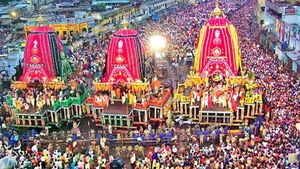Jagannath Rath Yatra: A Celebration of Faith and Devotion
Corps
The Jagannath Rath Yatra is one of the most important and vibrant festivals celebrated in India, attracting millions of devotees and tourists every year. Originating from Puri in Odisha, this grand event honors Lord Jagannath, a form of Lord Krishna. The festival is not just a religious occasion; it is a cultural extravaganza that showcases the rich traditions of India.
What is Jagannath Rath Yatra?
The Jagannath Rath Yatra, also known as the Car Festival, involves the grand procession of three deities—Lord Jagannath, his sister Subhadra, and his brother Balabhadra—who are placed in beautifully decorated chariots. This event takes place annually during the Hindu month of Ashadha (June-July) and marks the return of the deities from the Jagannath Temple to their garden, known as Gundicha Mandir.
Historical Background
The roots of the Jagannath Rath Yatra can be traced back to ancient times, with mentions in various scriptures and texts. The festival has been celebrated for centuries, and its rituals have evolved over time while maintaining their core significance. According to legends, the Yatra symbolizes the annual visit of Lord Jagannath to his garden to meet his devotees.
The Chariots
One of the most striking features of the Jagannath Rath Yatra is the enormous chariots, also called "raths." Each chariot is unique in design and size:
-
Jagannath's Chariot: Known as Nandighosh, it is the largest and is decorated in bright colors, primarily red and yellow. It stands about 45 feet tall and is pulled by thousands of devotees.
-
Balabhadra's Chariot: Named Taladhwaja, this chariot is green and has a more straightforward design compared to Jagannath’s chariot.
-
Subhadra's Chariot: Called Darpadalana, this chariot is smaller and features a yellow color scheme.
The construction of these chariots is a significant event, requiring immense craftsmanship and devotion. Artisans from different regions come together to create these masterpieces, showcasing traditional skills and artistry.
The Procession
The Rath Yatra begins at the Jagannath Temple in Puri, where the deities are brought out in a ceremonial procession. Devotees eagerly await this moment, chanting prayers and singing hymns. Once the deities are placed on their respective chariots, the procession moves towards Gundicha Mandir, which is about 2.5 kilometers away.
As the chariots roll down the streets, thousands of devotees pull them using ropes, creating a lively atmosphere filled with music, dance, and devotion. The streets are lined with people, and the air is filled with excitement and joy. Devotees often try to touch the chariots, believing that doing so brings them blessings.
Rituals and Traditions
The Jagannath Rath Yatra is steeped in rich rituals and traditions that enhance the spiritual experience for attendees. Some key rituals include:
-
Chhera Pahanra: This ritual is performed by the Gajapati (the king of Puri) who sweeps the chariots with a golden broom and sprinkles sandalwood paste. This act symbolizes humility and devotion.
-
Pulling the Chariots: The devotees pulling the chariots is a significant act of devotion. It is believed that everyone, regardless of caste or creed, can participate in this activity, emphasizing equality.
-
Offering Food: Throughout the festival, devotees offer a variety of foods to the deities, which is later distributed among the devotees as prasad (blessed food).
-
Return Journey: After staying in Gundicha Mandir for a week, the deities return to their temple in what is known as the Bahuda Yatra. This return journey is equally grand and filled with devotion.
Cultural Significance
The Jagannath Rath Yatra is not just a religious event; it holds immense cultural significance as well. The festival attracts people from different backgrounds and communities, promoting unity and harmony. It showcases the rich cultural heritage of Odisha and the diverse traditions of India.
Various forms of art and performances are displayed during the festival, including traditional dances, music, and theater. This cultural melange enriches the festival, making it a vibrant celebration of life and faith.
Pilgrimage and Tourism
For many devotees, the Jagannath Rath Yatra is a pilgrimage, and attending the festival is considered a significant spiritual journey. People travel from all corners of India and even from abroad to participate in the festivities.
The festival has also become a major tourist attraction, bringing economic benefits to the region. Local businesses thrive during the Yatra, as visitors flock to Puri to experience the celebrations. Hotels, restaurants, and handicraft markets see a surge in activity, making it a boon for the local economy.
Conclusion
The Jagannath Rath Yatra is a magnificent celebration of faith, culture, and community spirit. It draws people together in a shared experience of devotion and joy, making it one of the most revered festivals in India. Whether you are a devotee or a curious traveler, witnessing the Rath Yatra is an unforgettable experience that connects you to the heart and soul of Indian traditions.
As the chariots roll down the streets of Puri, they carry not just deities but also the hopes and aspirations of countless devotees. The festival continues to inspire generations, fostering a sense of unity and devotion that transcends borders and beliefs. So, if you ever get the chance, don’t miss the opportunity to witness this extraordinary event and immerse yourself in the vibrant atmosphere of the Jagannath Rath Yatra.










commentaires